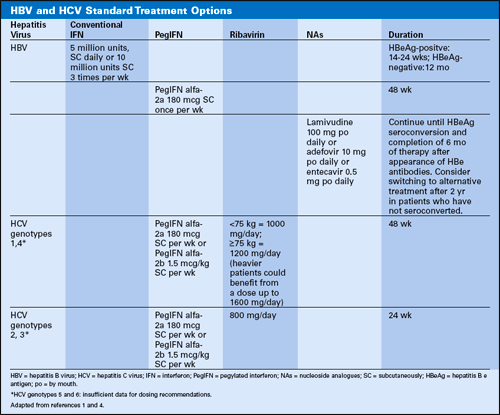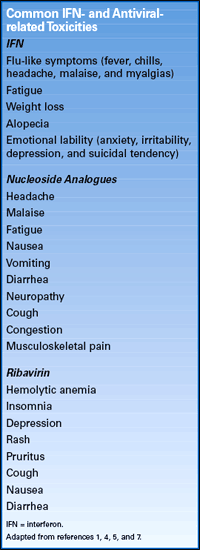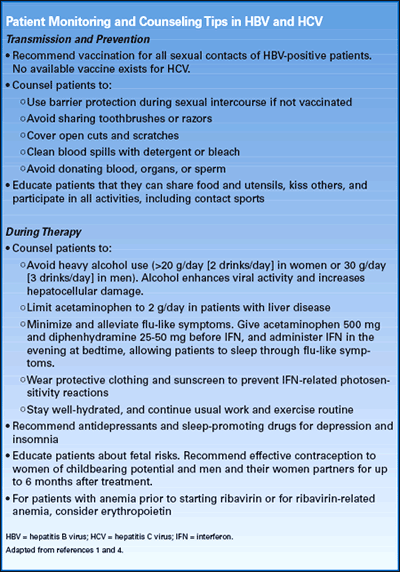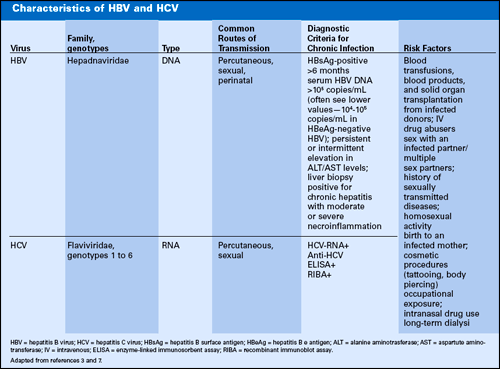Publication
Article
Pharmacy Times
Helping Hepatitis Patients Manage Their Disease
Author(s):
Pharmacists can improve care of patients with hepatitis B or C through recommendations, monitoring, and education.
Dr. Grandinetti is a senior clinical research pharmacist at the National CancerInstitute, National Institutes of Health, Rockville, Maryland. The views expressed arethose of the author and not those of any government agency.
Genetically and clinically, hepatitisB and C are 2 distinct viruses.According to the WorldHealth Organization, hepatitis B virus(HBV) infects an estimated 2 billionpeople worldwide and more than 350million chronically. An estimated 1.25million Americans are potentially infectiousHBV carriers (those testing positivefor hepatitis B surface antigen formore than 6 months); those who arehepatitis B e antigen (HBeAg)-positivehave the highest degree of infectivity.1Hepatitis C virus (HCV) infects approximately30.9 million Americans and 130million people worldwide, with mostinfected chronically.2
Acute HBV or HCV patients may beasymptomatic or have flu-like symptoms,anorexia, nausea, vomiting,abdominal pain, dark urine, and jaundice.Up to 90% of acute HBV casesresolve completely within a few weekswith lifelong immunity established; 9%progress to chronic infection, and 40%of these patients progress to cirrhosis,hepatic failure, or cancer.1,3 Unlike HBV,an estimated 85% of people infectedwith HCV develop chronic infection;cirrhosis occurs in approximately 30%of cases and hepatocellular cancer in2%. Cirrhotic patients may developascites, jaundice, muscle wasting,hepatic encephalopathy, and esophagealvarices. HCV is the most commonindication for liver transplantation.4,5
Both viruses are transmittedthrough direct exposureto blood and body fluids orby close person-to-personcontact through open cutsor sores. HCV's perinatal,sexual, and needle-stick transmissionrisk is lower than forHBV. Differences may be dueto HBV's more robust abilityto survive outside the bodyand the 2- to 4-log higher blood concentrationof the infected person.1,6
Treatment goals are to suppress viralreplication, induce remission, maintaintreatment adherence, and preventcomplications (cirrhosis, hepatic failure,and hepatocellular cancer). Becausetreatment-related toxicities cansignificantly lessen quality of life andability to function, minimizing adverseeffects is another important treatmentgoal.1,4
Table

HBV
For acute HBV patients, experts generallydo not recommend antivirals, butthey may benefit patients who are progressingto chronic infection. Conventionalor pegylated (Peg) interferon(IFN) and nucleoside analogues (NAs)—such as lamivudine, adefovir dipivoxil,or entecavir—are standard HBV treatmentoptions. PegIFN-alfa 2a (Pegasys)is the only pegylated formulation FDAapproved for chronic HBV. IFNs areadministered for predefined durations;whereas, NAs are given until specificend points are met (Table). HBeAgseroconversion, serum alanine aminotransferase(ALT) normalization, and adecrease in serum HBV DNA are usedto assess treatment efficacy.8 Viralmutation and drug resistance aremajor concerns with long-term lamivudinetherapy but less of a concern withadefovir and entecavir. Both are FDAapproved for lamivudine-resistant HBVpatients.1
HCV

Acute HCV patients may be treatedwith antivirals but only after sufficienttime (within 6 months of exposure) haspassed for spontaneous viral clearance.5 Standard treatment for chronic HCV isPegIFN plus ribavirin. PegIFNalone may be given topatients in whom ribavirinis contraindicated; however,ribavirin monotherapy isineffective against HCV.4,9Two PegIFN preparationsare FDA approved for chro-nic HCV: PegIFN alfa-2a, administeredas a fixed dose, and PegIFN alfa-2b(Peg-Intron), administered as aweight-based dose. No studies prove1 formulation superior to the other.4Medication selection, dose, andlength of therapy depend on the HCVgenotype (Table). Efficacy, defined asserum HCV RNA <50 IU/mL 6 monthsfollowing completion of therapy, ismonitored at baseline and periodicallyfor up to 6 months after therapy bymeasuring HCV RNA and serum ALTlevels.4,7
Conventional and Peg IFN havesimilar adverse-event profiles. Themost troublesome adverse event isemotional lability, including depressionand suicidal thoughts andattempts. Clinicians should assesspatients for depression before andperiodically during treatment. Serotoninreuptake inhibitors are oftenhelpful for depression.1,4
NAs are generally well-tolerated.Lamivudine and entecavir have similarsafety profiles, whereas nephrotoxicityis a major concern with adefovirSerum creatinine monitoring isnecessary during adefovir therapy.1
Hemolytic anemia associated withworsening cardiac function is ribavirin'sprimary toxicity. Hemoglobindecreases usually occur during thefirst 2 to 4 weeks of therapy. Duringtherapy, blood counts are monitoredweekly, and patients with preexistingcardiac disease should receive baselineelectrocardiograms and be monitoredappropriately thereafter. Thedose is often reduced or discontinuedin patients with decreased hemoglobinconcentrations.

For a table listing the characteristics of the hepatitis B and C viruses, please visit www.PharmacyTimes
.com/HBV_HCV.
Ribavirin is teratogenic and embryotoxic,and because of its long halflife,the risks are prolonged.Pregnancy tests are necessary beforetreatment and monthly for 6 monthsfollowing therapy. Ribavirin is eliminatedrenally and not removed byhemodialysis; thus, it is contraindicatedin patients with renal dysfunction(creatinine clearance <50 mL/min).4
Pharmacists can improve patientcare by ensuring patients receiveappropriate routine and follow-uptests, recommending therapies to minimizedrug-related adverse events,monitoring patient adherence, and providingpublic and patient HBV and HCVeducation.

Table

References
- Lok AS, McMahon BJ. Chronic hepatitis B. Hepatology. 2007;45:507-539.
- Global burden of disease (GBD) for hepatitis C. J Clin Pharmacol. 2004;44:20-29.
- Lai CL, Ratziu V, Yuen MF, Poynard T. Viral hepatitis B. Lancet. 2003;362:2089-2094.
- Yee HS, Currie SL, Darling JM, Wright TL. Management and treatment of hepatitis C viral infection: recommendations from the Department of Veterans Affairs Hepatitis C Resource Center program and the National Hepatitis C Program office. Am J Gastroenterol. 2006;101:2360-2378.
- Clark CH, Ghalib RH. Hepatitis C: role of the advanced practice nurse. AACN Clin Issues. 1999;10:455-463.
- Alter MJ. Epidemiology of hepatitis C virus infection. World J Gastroenterol. 2007;13:2436-2441.
- Chevaliez S, Pawlotsky JM. Hepatitis C virus: virology, diagnosis and management of antiviral therapy. World J Gastroenterol. 2007;13:2461-2466.
- Yuen MF, Lai CL. Recommendations and potential future options in the treatment of hepatitis B. Expert Opin Pharmacother. 2006;7:2225-2231.
- Schering-Plough Reports Top-Line Results of the IDEAL Study. Kenilworth, NJ: Schering-Plough. www.schering-plough.com/schering_plough/news/release.jsp?releaseID=1096126. Accessed January 14, 2008.







